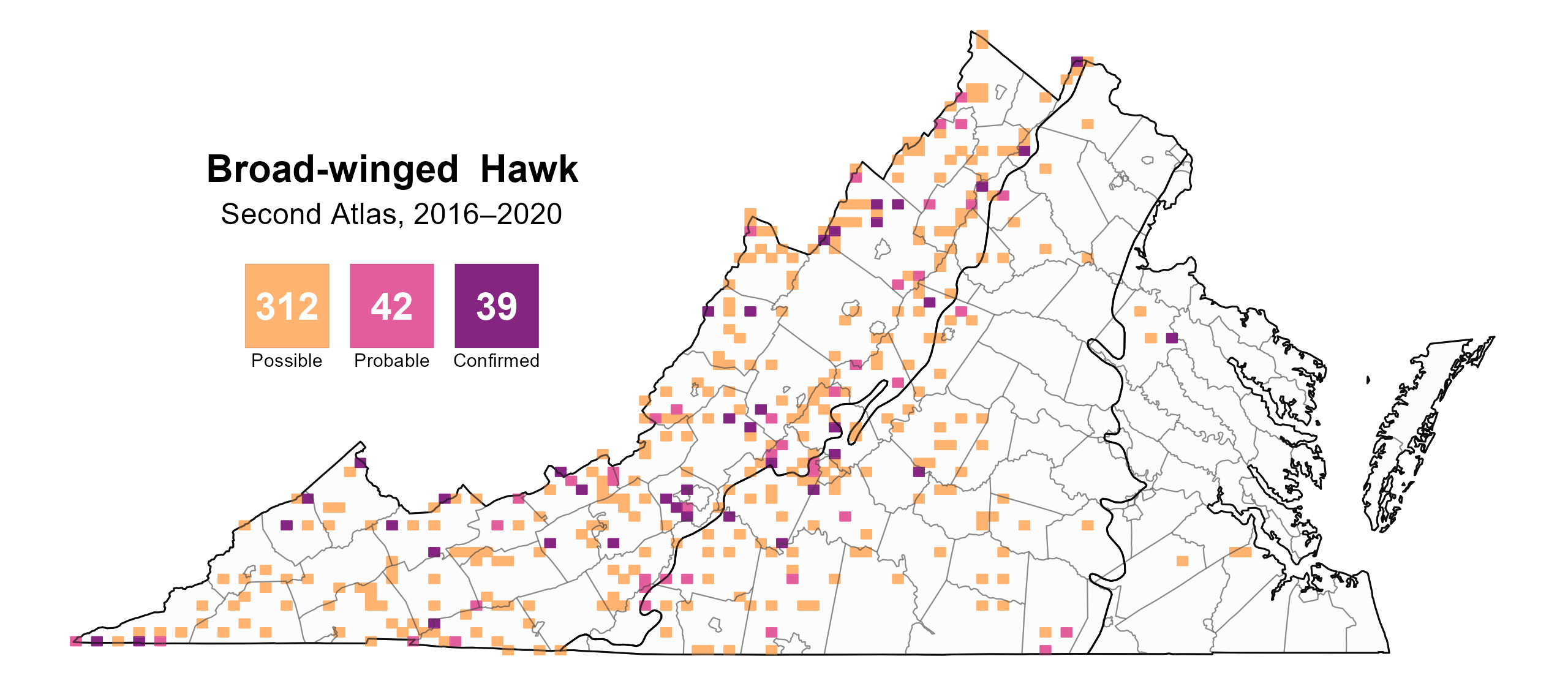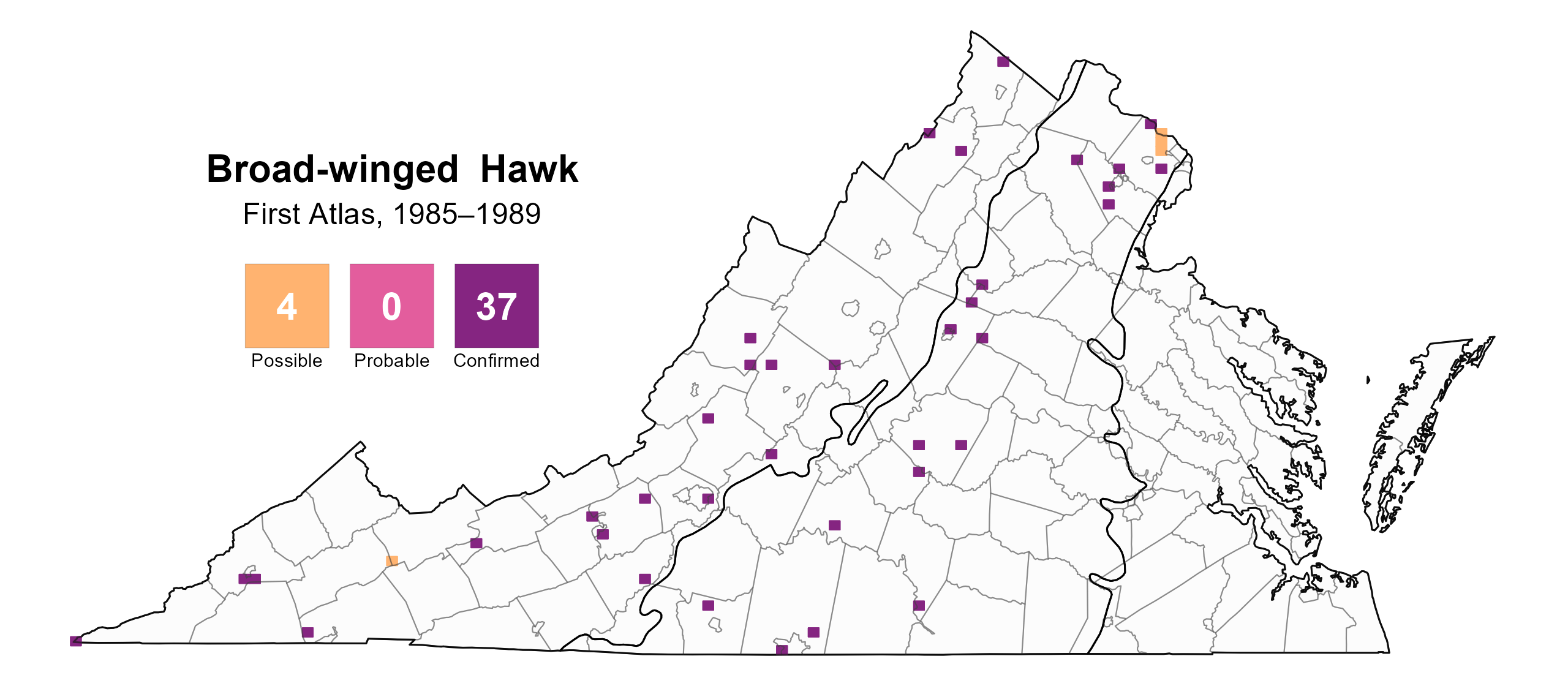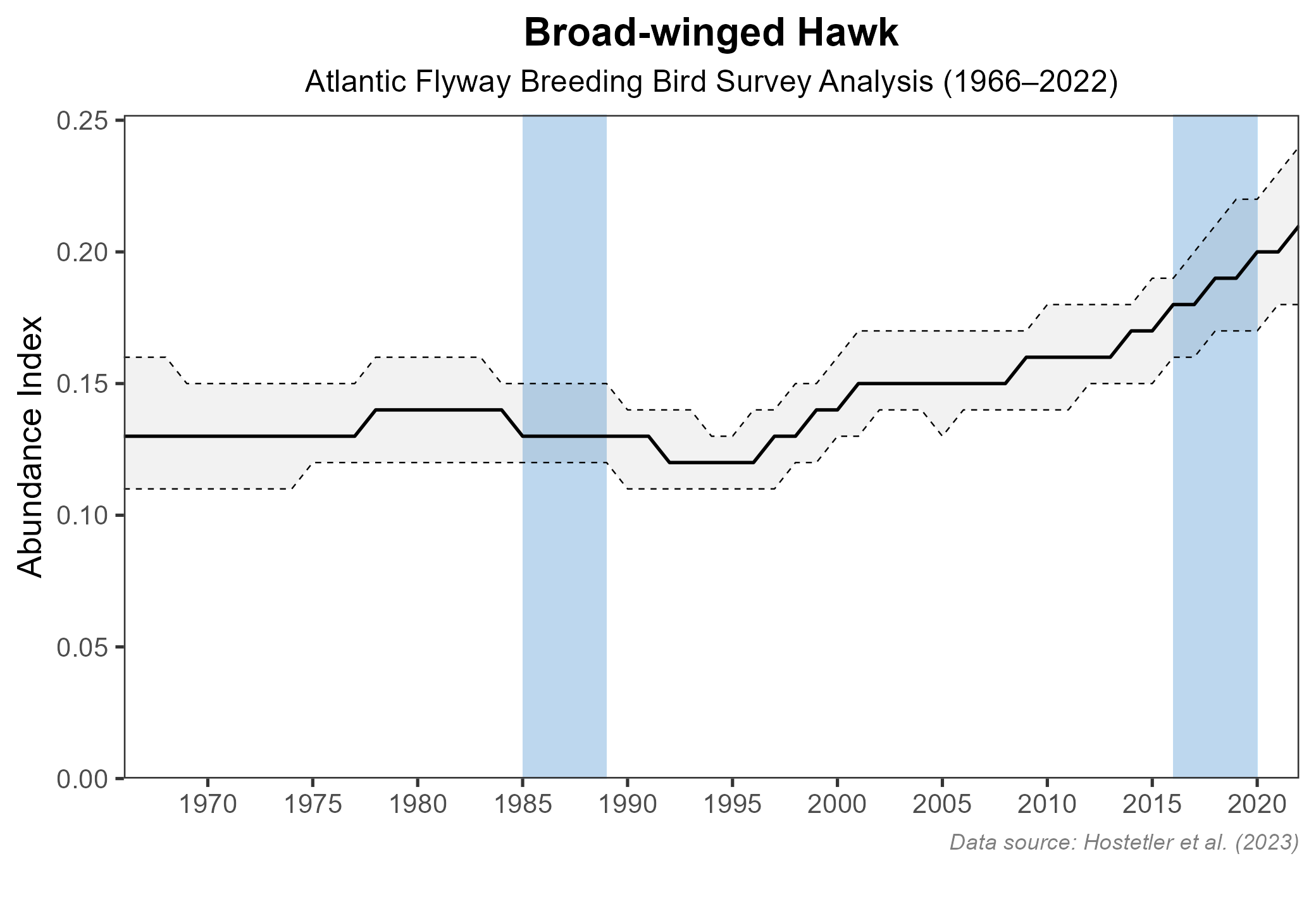Introduction
Broad-winged Hawks are stocky, reddish-brown raptors that, despite their abundance, often go unnoticed in Virginia and throughout their range. They are highly migratory, spending the winter in Central and South America and breeding throughout the central and eastern portions of the United States and southern Canada (Goodrich et al. 2020). While Broad-winged Hawks are dispersed and inconspicuous during the breeding season, they are often numerous and easily observed during migration. In the fall of 2023, volunteers at the Rockfish Gap Hawk Watch counted 28,462 of these hawks migrating along the Blue Ridge Mountains. The 10-year average for this species is 23,729, making it the most abundant migrating raptor in Virginia (Sattler et al. 2001; Rockfish Gap Hawk Watch website).
Breeding Distribution
Broad-winged Hawks occur in all regions of Virginia; however, they are most likely to occur in the complex of ridges in the Mountains and Valleys region. Specifically, this species has the highest likelihood of occurring in Alleghany, Bath, Buchanan, Craig, Dickinson, and Highland Counties (Figure 1). The likelihood of this species occurring in a block is strongly associated with the overall amount of forest cover, forest patch size, shrubland and grassland habitat, and agricultural and developed lands.
Due to data and model limitations, its distribution during the First Atlas and change between Atlases could not be modeled (see Interpreting Species Accounts). For more information on where the Broad-winged Hawk occurred during the First Atlas, please see the Breeding Evidence section.

Figure 1: Broad-winged Hawk breeding distribution based on probability of occurrence (Second Atlas, 2016–2020). This map indicates the probability that this species will occur in an Atlas block (an approximately 10 mi2 [26 km2] survey unit) based on environmental (including habitat) factors and after adjusting for the probability of detection (variation in survey effort among blocks).
Breeding Evidence
Broad-winged Hawks were confirmed breeders in 39 blocks and 22 counties and found to be probable breeders in an additional 13 counties (Figure 4). Fewer breeding observations were recorded during the First Atlas than during the Second Atlas, although survey effort was considerably less during the First Atlas (Figures 4 and 5).
Broad-winged Hawk nests are difficult to find, as they are usually constructed in canopies of dense forests and can be small. Thus, breeding activity was confirmed primarily through observations of recently fledged young rather than nests (Figure 6). Evidence of breeding activity was observed from late May, when the first fledged young and adults carrying nest material were recorded, through early August, when the last feeding of young was observed.
For more general information on the breeding habits of this species, please refer to All About Birds.

Figure 4: Broad-winged Hawk breeding observations from the Second Atlas (2016–2020). The colored boxes illustrate Atlas blocks (approximately 10 mi2 [26 km2] survey units) where the species was detected. The colors show the highest breeding category recorded in a block. The numbers within the colors in the legend correspond to the number of blocks with that breeding evidence category.

Figure 5: Broad-winged Hawk breeding observations from the First Atlas (1985–1989). The colored boxes illustrate Atlas blocks (approximately 10 mi2 [26 km2] survey units) where the species was detected. The colors show the highest breeding category recorded in a block. The numbers within the colors in the legend correspond to the number of blocks with that breeding evidence category.

Figure 6: Broad-winged Hawk phenology: confirmed breeding codes. This graph shows a timeline of confirmed breeding behaviors. Tick marks represent individual observations of the behavior.
Population Status
Abundance models for the Broad-winged Hawk could not be developed due to limited detections in the point count surveys. Based on the North American Breeding Bird Survey (BBS), the Broad-winged Hawk population showed a significant increase of 0.82% annually from 1966–2022 in Virginia (Hostetler et al. 2023; Figure 7). Similarly, the rate of increase between Atlas periods was a significant 1.08% per year from 1987–2018.

Figure 7: Broad-winged Hawk population trend for the Atlantic Flyway as estimated by the North American Breeding Bird Survey. The vertical axis shows species abundance; the horizontal axis shows the year. The solid line indicates the estimated population trend; there is a 97.5% probability that the true population trend falls between the dashed lines. The shaded bars indicate the First and Second Atlas periods.
Conservation
The Broad-winged Hawk is not a species of high conservation concern in Virginia; however, both broad and area-specific declines in probability of occurrence warrant further monitoring. The most concentrated areas of decline were in the greater Fairfax County and Richmond metropolitan areas, suggesting that loss of forest habitat might be a concern.
Interactive Map
The interactive map contains up to six Atlas layers (probability of occurrence for the First and Second Atlases, change in probability of occurrence between Atlases, breeding evidence for the First and Second Atlases, and abundance for the Second Atlas) that can be viewed one at a time. To view an Atlas map layer, mouse over the layer box in the upper left. County lines and physiographic regional boundaries (Mountains and Valleys, Piedmont, and Coastal Plain) can be turned on and off by checking or unchecking the box below the layer box. Within the map window, users can hover on a block to see its value for each layer and pan and zoom to see roads, towns, and other features of interest that are visible beneath a selected layer.
View Interactive Map in Full Screen
References
Goodrich, L. J., S. T. Crocoll, and S. E. Senner (2020). Broad-winged Hawk (Buteo platypterus), Version 1.0. In Birds of the World (A. F. Poole, Editor). Cornell Lab of Ornithology, Ithaca, NY. https://doi.org/10.2173/bow.brwhaw.01.
Hostetler, J. A., J. R. Sauer, J. E. Hines, D. Ziolkowski, and M. Lutmerding (2023). The North American breeding bird survey, analysis results 1966–2022. U.S. Geological Survey, Laurel, MD, USA. https://doi.org/10.5066/P9SC7T11.
Sattler, G. D., J. Perdue, D. Rich, and M. Zagorski (2021). Preliminary survey of autumn hawk migration in the Inner Piedmont of Virginia. Faculty Publications and Presentations. https://digitalcommons.liberty.edu/bio_chem_fac_pubs/39.




